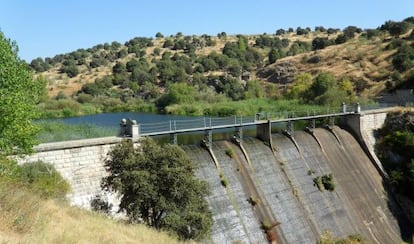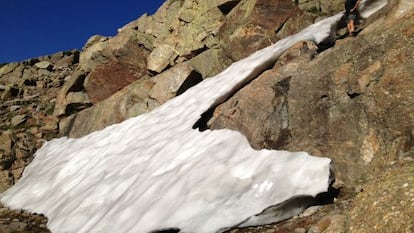Reservoir filled with toxic waste left abandoned on the River Guadarrama
Madrid public prosecutor investigating the origin of 300,000 cubic meters of polluted water The metals, hydrocarbons and organic matter would fill a third of the Bernabéu stadium

Around 300,000 cubic meters of mud contaminated with metals and organic material is currently lying at the bottom of the Aulencia reservoir, which is located in the Curso Medio Regional Park on the River Guadarrama, to the west of the city of Madrid. And for six years now, a clean-up operation has been pending.
In 2006, the Tagus Hydrographic Confederation (CHT) - a body that reports to the Environment Ministry, and which is responsible for the upkeep of the reservoir - announced that it was studying the best way to clean up the waste. But seven years on, the toxic sludge - which could fill a third of Real Madrid's Bernabéu stadium - is still there, two kilometers from the purification systems of the Valmayor reservoir. On the banks of the body of water, signs warn passersby that swimming is strictly prohibited.
The Madrid environmental prosecutor's office, which is headed up by Antonio Vercher, has opened an official investigation in an attempt to establish the origins of the mud and the reasons why it has accumulated there.
As far back as 2005, a report from the Center for Studies and Experimentation for Public Works (CEDEX) warned about the state of the water. The study revealed the presence of 12 metals (including cadmium, chromium, copper and manganese), as well as 74 pollutants (including soaps, hydrocarbons, solvents and textiles) and 31 solid compounds (including sulfur). The pollutants left the reservoir unusable, killing off any life and emitting foul smells.
When there is heavy rainfall the waters overflow and head downstream"
The report also added that the pollutants "appeared to correspond" to waste material from the water-purifying plant that treats water from the Valmayor reservoir, as well as sewage from the nearby town of Colmenarejo. But Madrid regional water company Canal de Isabel II denies that any such waste left its treatment plant at any time.
The CHT argues, however, that this is in fact the origin of the pollutants, and that they were dumped there after the Valmayor reservoir was put into use.
Sources from the CHT say that the pollutants are not seeping out through the water table, and that the river that flows downstream from the reservoir is not contaminated. There is, they add, no risk to the drinkable water supply given that the reservoir no longer serves the nearby municipalities.
"Theoretically, the mud stays on the bottom," explains Carlos González-Amezúa, a local councilor for Colmenarejo and a member of NGO Ecologists in Action. "But when there is heavy rainfall or storms, the waters overflow and head downstream. The mud is still there, despite the fact that we have filed a number of complaints over the years."
Santiago Martín Barajas, also from Ecologists in Action, adds that if the mud were to break the dam that holds the reservoir in place, the pollutants would reach the riverbed of the Aulencia, which is a tributary of the River Guadarrama, which in turn runs into the Tagus. "It would be a disaster," he says. What's more, he explains, if anyone were to fall into the reservoir, the mud would make it very difficult for them to get out again.
The mayor of Colmenarejo, Nieves Roses, of the center-right Popular Party, says that the council has done everything possible within the limits of the municipality's powers to restore the reservoir. Everyone agrees the mud must be cleared. The question is who will take the job on, how they will do it, and above all, when.
Madrid snowblocks survive summer

Despite more than three months of searing summer temperatures in central Spain, a few blocks of compacted snow can still be found from last winter in the mountains to the northwest of Madrid. Admittedly, the blocks - created by winds that drive snow into crevices - have survived only at the highest points (2,400 meters and above), and on north-facing mountainsides. But it still marks the first time in four decades winter snow has survived through the summer. "Most years, all the snow has gone by early July, and when there is rain and an early start to the summer, it barely lasts beyond mid-June," says Julio Vías, a writer and environmentalist, standing next to a huge slab of compacted snow and ice in the Peñalara range, around 70 kilometers north of the capital.
The formation is about 25 meters long, half as wide, and around a meter thick. "It will probably last a week or more, if it doesn't rain heavily," said Vías last week. He noted that the peculiarities of last winter, which was exceptionally tough, explain the existence of these blocks of snow so late in the year. Peñalara lake, which sits at the bottom of the range, froze over last winter, in places reaching a thickness of 179 centimeters - the densest since ice formation on the lake began to be measured in 1996. Furthermore, explains Vías, the ice lasted for more than four months, a month longer than the average over the last two decades.
The thickness of the snow accumulated over the winter in the nearby Cotos mountain pass has surpassed records, and was the deepest of the decade at 107 centimeters. This year's snowfalls have been heavier than any since 1996, with more than 140 liters per square meter in a single day. But they have not been distributed evenly, which has meant that the snow cover has lasted longer, giving the area an appearance it has not enjoyed in 50 years.
Snowfalls began to diminish in the Guadarrama mountain range, to which Peñalara belongs, in 1946, says Julio Muñoz of the Geography department of Madrid's Complutense University, who has been studying links between climate change and the formation of snowblocks. He says that it was not until 10 years ago that the first aerial photographs were taken of the area. Special walls were built in earlier centuries to collect snow and ice, which was then taken down to Madrid and sold to restaurants, bars and homes.
Muñoz says that while the survival of snow through to September is "an important event" it doesn't mean that it will happen again next year. He says that such snow and ice blocks take up to 10 years to form, and that they typically last for around 200 days. "They also provide the conditions for all sorts of plants to survive underneath them," he says, advising anybody interested in seeing the ice blocks to act quickly. "I don't think they will make it to winter."
Tu suscripción se está usando en otro dispositivo
¿Quieres añadir otro usuario a tu suscripción?
Si continúas leyendo en este dispositivo, no se podrá leer en el otro.
FlechaTu suscripción se está usando en otro dispositivo y solo puedes acceder a EL PAÍS desde un dispositivo a la vez.
Si quieres compartir tu cuenta, cambia tu suscripción a la modalidad Premium, así podrás añadir otro usuario. Cada uno accederá con su propia cuenta de email, lo que os permitirá personalizar vuestra experiencia en EL PAÍS.
¿Tienes una suscripción de empresa? Accede aquí para contratar más cuentas.
En el caso de no saber quién está usando tu cuenta, te recomendamos cambiar tu contraseña aquí.
Si decides continuar compartiendo tu cuenta, este mensaje se mostrará en tu dispositivo y en el de la otra persona que está usando tu cuenta de forma indefinida, afectando a tu experiencia de lectura. Puedes consultar aquí los términos y condiciones de la suscripción digital.
Últimas noticias
From Andorra to Gibraltar, a black market for Ozempic exploits its success: ‘They’re the most sought-after products in the world’
From Hungary’s Orbán to Chile’s Kast: How Trump helps turbo charge the far right
Magnets in their heads: How some animals guide themselves using the Earth’s magnetic field
The brief rise and retreat of Generation Z in Mexico
Most viewed
- Why we lost the habit of sleeping in two segments and how that changed our sense of time
- Trump’s obsession with putting his name on everything is unprecedented in the United States
- Charles Dubouloz, mountaineering star, retires at 36 with a farewell tour inspired by Walter Bonatti
- The Florida Keys tourist paradise is besieged by immigration agents: ‘We’ve never seen anything like this’
- Living in a motorhome due to soaring housing prices in Madrid: ‘I got used to it quickly, but I don’t idealize it’









































